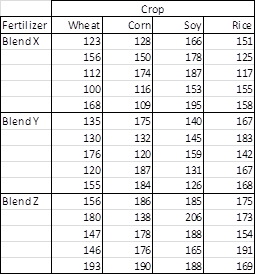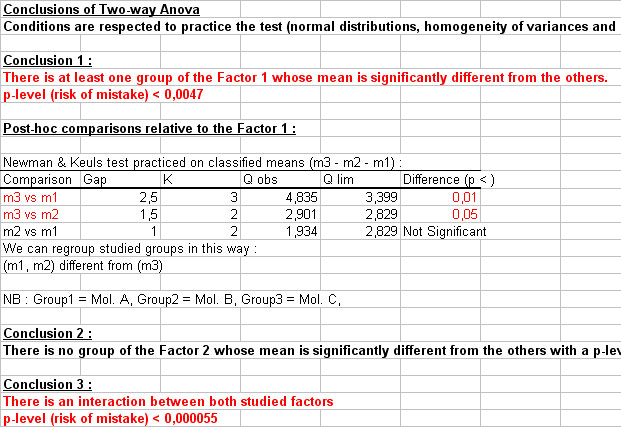
The most interesting cells are the ones corresponding to the four sum squares. Observation: Although the analysis in Figure 2 was produced automatically by Excel’s data analysis tool, the same result can be produced using Excel formulas, just as we were able to do in Basic Concepts of ANOVA for one-way ANOVA. 05 = α (or F = 2.63 < 4.76 = F-crit) we can’t reject the null hypothesis, and so at 95% level of confidence we conclude there is no significant difference in the yields for the four crops studied.

H 0: there is no significant difference in yield between the (population) means for the crop types 0068 5.14 = F-crit) we reject the null hypothesis, and so at the 95% level of confidence we conclude there is significant difference in the yields produced by the three blends. H 0: there is no significant difference in yield between the (population) means of the blends There are two null hypotheses: one for the rows and the other for the columns.
#Error for rows when calcualting two way anova in excel how to
We now return to Example 1 and show how to conduct the required analysis using Excel’s Anova: Two-factor Without Replication data analysis tool.Įxample 1 (continued): The output from the data analysis tool is shown in Figure 2.įigure 2 – Two factor ANOVA w/o replication data analysis tool


Proof: The result follows from Property 2 and Theorem 1 of F Distribution. If all μ j are equal and all are equal then If all μ iare equal and all are equal then Theorem 1: Suppose a sample is made as described in Definitions 1 and 2, with the x ijindependently and normally distributed. Proof: The proof is similar to that of Property 1 of Basic Concepts for ANOVA. Property 2: If a sample is made as described in Definition 1, with the x ijindependently and normally distributed and with all (or ) equal, then If we square both sides of the equation, sum over i, j and then simplify (with various terms equal to zero as in the proof of Property 2 of Basic Concepts for ANOVA), we get the first result. As before we have the sample version x ij= x̄ + a i + b j + e ijwhere e ijis the counterpart to ε ijin the sample.ĭefinition 2: Using the terminology of Definition 1, defineĬorrection: The term x ij in the formula for SS E in the above table should not have a bar over it. If testing for factor B, the null hypothesis is equivalent toįinally, we can represent each element in the sample as x ij = μ + α i + β j + ε ijwhere ε ijdenotes the error (or unexplained amount). If testing for factor A, the null hypothesis is equivalent to The two-way ANOVA will either test for the main effects of factor A or factor B, namely We have a similar estimate for the sample of x̄ j = x̄ + b j. the departure of the jth level mean μ j for factor B from the total mean μ). Similarly, we estimate the level means from the total mean for factor B by μ j = μ + β jwhere β jdenotes the effect of the jth level for factor B (i.e. We have a similar estimate for the sample of x̄ i = x̄ + a i. the departure of the ith level mean μ ifor factor A from the total mean μ). We estimate the level means from the total mean for factor A by μ i = μ + α i where α idenotes the effect of the ith level for factor A (i.e. We use terms such as x̄ i (or x̄ i.) as an abbreviation for the mean of. Thus we use an r × c table where the entries in the table are factor A) and the index j for the columns (i.e. We organize the levels for factor A as rows and the levels for factor B as columns. Factor A has r levels and factor B has c levels. In general, suppose we have two factors A and B.

The blend factor has 3 levels and the crop factor has 4 levels. In Example 1 there are two factors: blends and crops. A k factor ANOVA addresses k factors.Ī level is some aspect of a factor these are what we called groups or treatments in the one-factor analysis discussed in Basic Concepts for ANOVA. We interrupt the analysis of this example to give some background, after which we will resume the analysis.ĭefinition 1: We define the structural model as follows.Ī factor is an independent variable. The crop yields for the 12 combinations are as shown in Figure 1. They test each of the three blends on one sample of each of the four types of crops. To help introduce the basic concepts we start with the following example.Įxample 1: A new fertilizer has been developed to increase the yield on crops, and the makers of the fertilizer want to better understand which of the three formulations (blends) of this fertilizer are most effective for wheat, corn, soybeans and rice (crops).


 0 kommentar(er)
0 kommentar(er)
